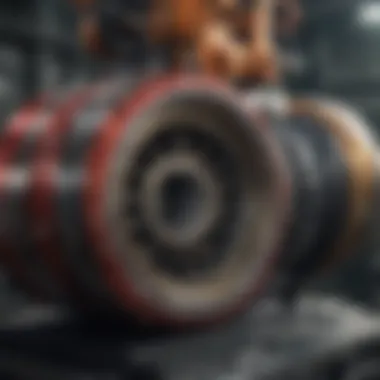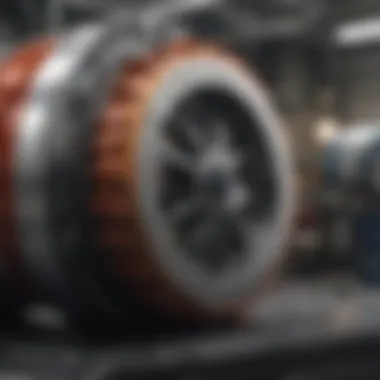In-Depth Exploration of Motor Machining in Agriculture


Intro
Motor machining is a critical process that contributes significantly to the efficiency and effectiveness of agricultural practices. As farming becomes more technologically advanced, the role of precise motor machining continues to grow. This article will delve into various aspects of motor machining relevant to agriculture, providing insights that professionals and enthusiasts will find beneficial. Understanding these processes not only enhances operational knowledge but also fosters innovation and sustainability in farming.
Key Insights
Overview of the Topic
Motor machining involves the fabrication and maintenance of various engine components that power agricultural machinery. This process is integral to ensuring machinery operates at optimal levels. Core operations involve machining methods, precision engineering, and adherence to quality standards. Each component must meet specific requirements to withstand the rigors of agricultural environments. The right machining techniques can extend the life of equipment and improve productivity in farming operations.
Importance in Agriculture/Horticulture/Agronomy
Motor machining is vital in agriculture because it impacts the performance of various machines used across the sector. From tractors to harvesters, the efficiency of these machines directly affects yield, operational costs, and farming practices.
- Increased Efficiency: Well-machined components lead to reduced wear and tear, enabling machines to function better over time.
- Reduced Downtime: Regular maintenance and quality machining contribute to reducing equipment failures, ultimately saving time and costs.
- Sustainability: Precision in motor machining can lead to more efficient fuel use and lower emissions, aligning with eco-friendly farming goals.
"Motor machining not only optimizes equipment performance but also supports sustainable farming practices that are essential for the future of agriculture."
Sustainable Practices
Eco-Friendly Techniques
Sustainable motor machining practices are increasingly pertinent. Techniques such as recycling waste materials and using energy-efficient machinery can significantly reduce the environmental impact. Some farms have adopted advanced tools that minimize waste and energy consumption.
Case Studies on Sustainability
Several case studies highlight the effective integration of sustainable motor machining practices:
- Organic Farms: Some organic farms have successfully integrated bio-fuels and eco-friendly lubricants in their machinery, promoting a cleaner environment.
- Technology Adoption: Innovative startups in agriculture are pushing for greener approaches, developing machines that optimize fuel usage and decrease emissions.
Tools & Resources
Essential Equipment and Technologies
In motor machining, various tools are essential to achieve high precision. Critical equipment includes:
- CNC machines
- Lathes
- Milling machines
- Inspection tools
These tools improve the quality of the machining process and enhance overall equipment efficiency.
Recommended Books and Readings
For those interested in learning more about motor machining in agriculture, the following resources can be invaluable:
- "The Machinist's Handbook" - A comprehensive guide to machining processes and techniques.
- "Farm Machinery and Equipment" - This book focuses on the importance of well-maintained machinery in agriculture.
For more information, you may visit Wikipedia, Britannica, Reddit for community discussions, or Facebook groups dedicated to farming technologies.
Understanding Motor Machining
Motor machining is an essential discipline within the agricultural sector. Its significance resonates deeply in the production, maintenance, and customization of machinery used in farming. Motor machining involves various processes, each tailored to enhance the efficiency and efficacy of agricultural operations.
By grasping motor machining, one gains insight into how agricultural machinery is engineered and repaired. This understanding offers numerous benefits, from improving the longevity of machines to increasing productivity on the farm. Furthermore, it sheds light on the specific considerations one must take into account, such as material properties, tolerances, and machining techniques.
An adept knowledge of motor machining allows farmers and enthusiasts to recognize when and how to implement these processes. It ensures they can respond effectively to issues that arise, whether they be mechanical failures or the need for upgrades. Ultimately, understanding motor machining shapes the way we approach agricultural tasks and can enhance overall operational success.
Definition and Scope
Motor machining refers to the processes involved in cutting, shaping, and assembling motors and related components. This broad field covers everything from the initial design concepts to the intricate finishing touches. The scope of motor machining includes techniques such as turning, milling, and grinding, tailored specifically for motors utilized in agricultural machinery.
The key elements of motor machining focus on precision and accuracy. Each part must adhere to rigorous specifications to ensure optimal performance. As a result, the relationship between design and execution becomes critical. When understanding motor machining, one must also consider the tools and materials employed, as these influence the feasibility and quality of the final product.
History of Motor Machining
The evolution of motor machining can be traced back to the industrial revolution, when advances in technology began to transform manufacturing processes. Initially, machining was rudimentary, relying heavily on manual labor and basic tools. Over time, these methods developed into more sophisticated techniques, utilizing machinery that increased efficiency and precision.
In the late 19th and early 20th centuries, motor machining saw significant progress with the introduction of electrical motors. These innovations allowed for new machining processes that were faster and more reliable. Technological advancements continued into the 21st century, where computer numerical control (CNC) machining brought a new era of precision and automation.
Understanding the history of motor machining provides a foundation for current practices. It illustrates how far technology has come and highlights the continuous evolution within the field. This backdrop is crucial for appreciating the complex machinery that plays a vital role in modern agricultural practices.
Fundamental Machining Processes
Fundamental machining processes are essential for understanding how various components in agricultural machinery are created and refined. In motor machining, these processes form the backbone of manufacturing that ensures the efficiency, durability, and performance of agricultural implements. Each process has distinct characteristics and applications that are crucial for farmers and manufacturers alike.
Turning Operations


Turning operations are a vital machining technique where a rotating workpiece is shaped using a single-point cutting tool. This method is particularly effective for producing cylindrical shapes, which are common in parts like shafts and axles used in tractors and other farm machinery. The precision of turning allows manufacturers to achieve tight tolerances essential for the fitment of components in agricultural applications. Moreover, this operation can be executed on both manual lathes and modern CNC lathes, enhancing flexibility in production.
Some advantages of turning operations include:
- High dimensional accuracy
- Capability to create complex shapes
- Versatility of materials used, from metals to plastics
Nevertheless, turning does come with considerations. Tool wear can impact surface finish and dimensional accuracy, necessitating regular monitoring and tool replacements to sustain quality output.
Milling Processes
Milling processes are another cornerstone of motor machining, employing rotary cutting tools to remove material from the workpiece. This method is crucial for creating flat and contoured surfaces and is often used to produce gears, brackets, and other components pivotal in agricultural machinery. The flexibility of milling allows for various operations like face milling, slot milling, and contour milling, making it suitable for diverse applications.
Some key benefits of milling processes include:
- Capability to produce intricate shapes and features
- High production rates for bulk parts
- Ability to machine a variety of materials, including hardened metals
However, operators must pay attention to the setup and tool selection to prevent issues like chatter or tool breakage. Also, proper coolant application is necessary to minimize heat build-up, ensuring that components maintain their structural integrity throughout the machining process.
Grinding Techniques
Grinding techniques are used primarily for finishing operations, which improve the surface finish and dimensional accuracy of machined components. It involves using abrasive wheels to remove material, making it ideal for achieving very precise tolerances. In agricultural machinery, grinding is often performed on surfaces that demand high accuracy, such as bearing seats and valve seats.
The benefits of grinding techniques include:
- Attaining high surface quality
- Capability to remove very little material while improving overall dimensions
- Obliging for hard materials that cannot be machined by other methods
Nonetheless, grinding requires careful operations as it can generate heat that may distort the workpiece. Proper preparation of the workpiece and selection of the right grinding wheel are essential for optimal results.
Ultimately, mastering these fundamental machining processes not only enhances performance but also contributes to the longevity of agricultural machinery, making them indispensable in modern agriculture.
By understanding these core processes, agricultural professionals can make informed decisions regarding the manufacturing and maintenance of the machinery they rely on, optimizing operations for better productivity.
Key Tools in Motor Machining
In motor machining, tools are paramount for efficiency and precision. This section focuses on three significant types of tools utilized in the industry: cutting tools, measuring instruments, and finishing tools. Each category serves a distinct purpose and plays an essential role in the overall process of motor machining, particularly in agriculture, where high standards and reliability are crucial.
Cutting Tools
Cutting tools are fundamental in shaping and removing material from metals or other materials during machining processes. Their effectiveness directly influences the quality of the machined parts. There are various types of cutting tools including drills, lathes, and milling cutters. Each type is designed for specific operations, which can greatly affect productivity.
Key considerations in selecting cutting tools include:
- Material Composition: The tool material, such as high-speed steel or carbide, affects durability and performance.
- Geometry: The design of the cutting edge contributes to efficiency.
- Cooling Systems: Proper cooling minimizes wear and extends tool life.
Using the right cutting tool improves the quality of the finished product and reduces production time. Poor tool selection can lead to increased downtime and higher costs.
Measuring Instruments
Measuring instruments ensure that parts are manufactured to precise specifications. Common instruments include calipers, micrometers, and gauges. These tools not only measure dimensions but also allow for quality control throughout the machining process.
Key aspects of measuring instruments are:
- Accuracy: High accuracy is essential for maintaining tolerances in production.
- Calibration: Regular calibration prevents discrepancies that could affect the final product.
- Ease of Use: Instruments should be user-friendly to enhance workflow.
Effective measurement tools reduce errors, which is critical for safety and functionality in agricultural machinery. They provide the data needed for continuous improvement in machining processes.
Finishing Tools
Finishing tools are used after the primary machining processes to achieve a high-quality surface finish. This is particularly important in applications where smooth surfaces are essential, like in engines or hydraulic systems.
The types of finishing tools include:
- Grinders: Useful for smoothing surfaces and achieving tight tolerances.
- Honers: Improve the finish of cylindrical surfaces.
- Polishers: Provide a high gloss finish.
Considerations for using finishing tools are:
- Surface Finish Requirements: Different applications require varying finishes.
- Material Compatibility: Matching the tool to the workpiece material prevents damage.
The use of finishing tools ultimately allows for enhanced performance of the machined parts, which is vital for machinery reliability in agriculture.
"The right tools not only enhance the machining process but also contribute to the durability and efficiency of agricultural machinery."
In summary, the tools used in motor machining are integral to production effectiveness. By understanding the various types, farmers and enthusiasts can make informed choices that improve their machinery and, ultimately, their agricultural output.
Role of Technology in Motor Machining


The role of technology in motor machining is pivotal in shaping the way agricultural machinery is fabricated, operated, and maintained. As technology advances, it consistently improves precision, efficiency, and productivity. The application of modern techniques in motor machining not just enhances performance but also lowers costs and minimizes time spent on tasks. It is essential for farmers and agricultural professionals to understand these technological innovations because they directly impact their operations and overall success in the field.
CNC Machining
CNC machining has revolutionized the motor machining domain. CNC stands for Computer Numerical Control and it enables machines to be automated with high precision. This process reduces human error and increases output consistency. By using CNC technology, manufacturers can create intricate parts that meet exact specifications. For instance, components like gears or hydraulic systems are often produced with CNC lathes or milling machines. The ability to replicate designs with outstanding accuracy is a significant advantage, especially when it comes to machinery repair or production of replacement parts.
Moreover, CNC machining allows for rapid prototyping. A part can be designed, tested, and refined in a shorter timeframe than traditional methods would allow. This accelerates the development process and helps farmers get their machinery running faster when parts need replacement.
Software Innovations
Software developments have also transformed motor machining significantly. Design and manufacturing software assist engineers and technicians in creating high-quality parts. Programs like SolidWorks or AutoCAD enable detailed 3D modeling. This level of detail helps identify potential issues before physical production begins, potentially saving time and money.
The integration of software in motor machining goes beyond design. Inventory management systems track parts and materials, ensuring that the necessary components are available when needed. Software solutions can analyze production data to identify bottlenecks, allowing for improved workflow management. It also enables better communication among teams, improving teamwork and project coordination. Ultimately, embracing software innovations is not just a trend but a necessity for modern motor machining in agriculture.
Automation Impact
Automation has been one of the most significant trends influencing motor machining. The inclusion of robotics in the manufacturing process yields remarkable productivity improvements. Automated systems can perform repetitive machining tasks with precision and speed, which is particularly beneficial in high-volume production environments. This shift reduces labor costs and offsets the skill gaps often present in the workforce.
Furthermore, automation facilitates monitoring and maintenance of machinery. Sensors installed on machining equipment provide real-time data regarding their operation. This data is essential for predictive maintenance, which can significantly reduce downtime. It allows technicians to address issues before they lead to machinery failure. Hence, automation not only boosts productivity but also enhances reliability and lifespan of farming equipment.
Overall, the role of technology in motor machining is foundational for evolution in agriculture. CNC machining, software innovations, and automation advance practices, benefiting farmers and agricultural professionals alike. Understanding and integrating these technologies into operations will prove vital for staying competitive in today’s rapidly changing agricultural world.
Applications in Agriculture
Motor machining plays a crucial role in the efficiency and innovation of agriculture. It underpins the production of agricultural machinery, facilitates customization of components, and supports repair and maintenance. Each of these areas impacts farm productivity, machinery longevity, and overall operational success. Understanding these applications provides insight into how motor machining reinforces agricultural practices.
Machinery Production
The production of agricultural machinery relies heavily on precise motor machining. This process includes the manufacture of equipment like tractors, harvesters, and irrigation systems. Each machine is designed to perform specific tasks with efficiency. Well-machined components ensure that these machines function optimally.
The benefits of effective machinery production are multifaceted:
- Increased Efficiency: Well-crafted machinery improves operational speed and reduces energy consumption.
- Longevity of Equipment: High-quality machining leads to machines that can withstand harsh agricultural environments.
- Cost-effectiveness: Investing in quality machinery minimizes the costs associated with repairs and replacements.
The production process must be continually refined to meet the changing needs of the agricultural sector. This ensures that operators remain competitive and adapt to new farming technologies. Furthermore, collaboration between manufacturers and farmers can lead to innovations that directly address field challenges.
Component Customization
Customization of components is another vital area where motor machining makes a significant impact. Tailoring machinery to meet the unique demands of different agricultural practices enhances productivity. Farmers often require specific features that standard machinery does not provide. For instance, a farmer might need modifying the cutting width of a combine harvester for certain crops.
Key aspects to consider regarding component customization include:
- Adaptability: Customized components allow machines to handle diverse agricultural tasks.
- Improved Functionality: Enhances machine capabilities, potentially leading to higher yields.
- Personalization: Farmers can personalize equipment based on their specific operational challenges.
Investing in component customization can lead to a more efficient farming operation. This strategy not only facilitates handling different crops but also helps in responding to evolving agricultural practices over time.
Repair and Maintenance
Repair and maintenance of machinery are essential for sustained performance and productivity. Using effective motor machining techniques, farmers can ensure that their equipment remains in top condition. Regular maintenance reduces the incidence of breakdowns, which can lead to costly downtime.
Important practices in repair and maintenance include:
- Preventive Checks: Regular inspections before planting and harvesting seasons can identify issues early.
- Corrective Actions: Quick repairs using properly machined parts can extend machinery life.
- Upkeep of Components: Regularly servicing specific machine parts helps sustain performance and prevents premature failures.
Effective repair and maintenance strategies help balance the costs of owning and operating machinery. Investing in these practices ultimately supports the longevity and reliability of agricultural equipment, which is critical for successful farming operations.
"Efficient repair and maintenance can reduce 30% of a farmer's operational downtimes, significantly impacting productivity."
Maintenance Practices
Maintenance practices in motor machining are crucial for ensuring optimal performance, extending machinery lifespan, and reducing operational costs. The agricultural sector relies heavily on efficient motor systems. Thus, implementing robust maintenance strategies can have a significant impact on productivity and equipment reliability.
Preventive Maintenance
Preventive maintenance involves the regular inspection and servicing of machinery to prevent potential issues before they arise. Key benefits of preventive maintenance include:
- Reduced Downtime: By identifying and resolving potential problems before they escalate, farmers can minimize unplanned downtime, which can disrupt critical harvesting or planting activities.
- Cost Efficiency: Although preventive maintenance requires an upfront investment in time and resources, it often results in lower long-term costs by avoiding major repairs.
- Enhanced Safety: Regular checks can identify safety hazards, thus protecting operators and reducing the risk of accidents.
To effectively implement preventive maintenance, farmers should develop a maintenance schedule that includes checking fluid levels, lubricating moving parts, and examining belts and hoses for wear and tear. Tools such as checklists can help ensure that all necessary tasks are completed systematically.
Troubleshooting Techniques
Troubleshooting techniques are essential when machinery fails or performs below expectations. An effective troubleshooting process can save time and resources. Steps for effective troubleshooting include:
- Identifying Symptoms: Recognizing unusual noises, vibrations, or operational failures can often pinpoint where an issue may lie.
- Consulting Manuals: Equipment manuals typically contain troubleshooting sections specific to the machinery, guiding operators through common problems and solutions.
- Systematic Testing: Testing components in a logical order can help isolate the issue, whether it's electrical, mechanical, or software-related.
- Documenting Findings: Keeping a log of issues and solutions can aid in future troubleshooting efforts and help build a knowledge base for the farm operation.


By mastering troubleshooting techniques, farmers can respond more effectively to machinery issues, reducing repair times and costs.
Replacement Strategies
At times, machinery components may need to be replaced rather than repaired. Developing an effective replacement strategy is important for ensuring continued operational efficiency. Some considerations in this process include:
- Cost-Benefit Analysis: Evaluate whether replacing a component is more economical than repairing it. Consider long-term benefits over immediate costs.
- Quality of Replacement Parts: Using original equipment manufacturer (OEM) parts may result in better compatibility and performance compared to generic alternatives.
- Outdated Technology: When replacing equipment, consider newer models that may offer advanced features or greater efficiency.
- Maintenance History: Review the operational history of the equipment to decide if it is worth investing in replacements rather than purchasing new machinery.
Challenges in Motor Machining
Motor machining is an essential part of the agricultural sector, but it does not come without significant hurdles. Understanding these challenges helps stakeholders develop effective strategies to overcome them. The challenges directly influence the efficiency and reliability of motor machining processes.
Material Limitations
Material limitations can hinder the effectiveness of motor machining. The type of materials used to manufacture machinery parts greatly impacts the machining process. Some materials, like high-strength alloys or composite materials, are difficult to machine due to their hardness or toughness. For instance, machining titanium requires specialized tools and techniques to avoid tool wear and maintain precision. Moreover, the availability of suitable materials can fluctuate based on market conditions, affecting operational consistency.
In addition, selecting the wrong materials may lead to premature failure of components. This can force farmers to seek replacements or repairs more frequently, which incurs additional costs. Thus, addressing material limitations is crucial for the sustainability and productivity of motor machining in agriculture.
Skill Gaps in Workforce
The skill levels of the workforce present another challenge in motor machining. A skilled workforce is necessary for the proper operation of complex machinery and for adhering to safety standards. However, there is often a gap between the skills needed and those available in the market. Many agricultural professionals may lack advanced knowledge of CNC machining or proficiency in the use of specific tools and machines.
Training and education programs must be implemented to bridge this gap. Investments in workforce development will not only improve operational efficiency but also enhance safety on the job. Adequately trained workers can troubleshoot issues, reducing downtime from faulty machinery and helping in the long-term sustainability of agricultural practices.
Technological Adaptation
Technological adaptation is critical as the industry evolves. New machinery and processes emerge regularly, often incorporating technologies like IoT and automation. Adapting to these changes can pose a challenge for many agricultural enterprises, especially smaller farms with limited resources. Resistance to change is common; some workers may prefer traditional methods over newer technologies.
Embracing new technologies can lead to significant advancements in efficiency and product quality. For example, integrating IoT into machinery allows for real-time monitoring and predictive maintenance, minimizing unexpected breakdowns. Thus, fostering a culture that embraces innovation is vital for future competitiveness in motor machining.
"Addressing these challenges is essential to harnessing the full potential of motor machining in agriculture, enabling the sector to thrive in a rapidly changing landscape."
To summarize, the challenges in motor machining, including material limitations, skill gaps in the workforce, and technological adaptation, need careful consideration. By facing these issues directly, stakeholders can enhance the efficiency, reliability, and sustainability of motor machining processes.
Future Trends in Motor Machining
The future of motor machining is shaped by various evolving trends, important not just for advancements in efficiency but also for sustainability. Understanding these trends can enhance operations in agriculture, making them more productive and environmentally friendly. Key elements include sustainability initiatives, integration with the Internet of Things (IoT), and the use of advanced materials.
Sustainability Initiatives
Sustainability initiatives are becoming essential to the practices of motor machining. There is a growing awareness of the environmental impact of manufacturing processes. Implementing eco-friendly techniques minimizes waste and reduces energy consumption.
- Energy Efficiency: Utilizing machines with lower energy requirements helps in decreasing the carbon footprint. This is achieved through advancements in motor designs and manufacturing methods.
- Waste Management: Emphasizing recycling and proper disposal of materials used in machining can limit harmful waste.
- Biodegradable Lubricants: Innovations in lubricants that are eco-friendly contribute to better environmental health during machining.
Agricultural professionals are increasingly focusing on these methods, making their processes more resilient against future regulations and offering potential cost savings due to reduced resource consumption.
Integration with IoT
The integration of IoT devices in motor machining is a significant trend that promotes enhanced connectivity and control. By linking machinery and devices via the Internet, farmers can achieve optimized operations.
This connectivity allows for:
- Real-time Monitoring: Farmers can track the performance and condition of machines closely. Immediate data provides alerts to any issues, reducing downtime in operations.
- Predictive Maintenance: Using IoT technology can predict when machines require maintenance. This ensures that operations remain uninterrupted and costs associated with unplanned repairs are minimized.
- Efficient Resource Management: IoT systems can streamline inputs like fuel and materials based on real-time requirements, optimizing the overall efficiency of operations.
As the agricultural sector embraces smart farming technologies, the integration of IoT will play a crucial role in enhancing productivity and reducing operational costs.
Advanced Materials Usage
The usage of advanced materials in motor machining is an interesting trend that has valuble implications. These materials can lead to stronger and more durable equipment, which is vital for the challenging conditions in agriculture.
Some advancements include:
- Lightweight Composites: These materials are beneficial for reducing the overall weight of machinery, improving fuel efficiency while maintaining strength.
- High-Performance Alloys: Enhanced alloys that withstand wear and corrosion extend the lifespan of cutting tools, leading to lower replacement costs and improved functionality in various environments.
- Smart Materials: Utilization of materials that can adapt to different conditions opens up opportunities for innovation in machine design and functionality.
Incorporating these advanced materials can lead to improved performance and longevity of machinery, which in turn supports sustainable practices in agriculture.
"Future trends in motor machining are not merely technological novelties; they profoundly influence agricultural productivity and sustainability."
Closure
In the intricate world of motor machining, understanding the various facets discussed throughout this article is vital for agricultural professionals and enthusiasts. The conclusion constitutes a synthesis of the essential elements that contribute to effective motor machining practices.
Firstly, the significance of motor machining lies in its role as a backbone for agricultural machinery production. Efficiency and precision in machining directly impact the performance and reliability of agricultural equipment. By mastering the fundamental machining processes and selecting the appropriate tools, professionals can optimize production outcomes.
Next, one cannot overlook the implications of maintenance practices. Regular preventive maintenance and effective troubleshooting strategies preserve the functionality of machinery, ensuring longevity and operational success. This leads to reduced downtime, which is particularly crucial in time-sensitive agricultural operations.
Moreover, the challenges highlighted within the industry, such as material limitations and skilled labor gaps, demand attention. Addressing these challenges through continuous learning and adaptation will promote more resilient machining practices. As technology evolves, adapting to innovations will be necessary for future competitiveness.
Additionally, the exploration of future trends showcases a commitment to sustainability and advanced material usage. Sustainable practices are increasingly relevant in agriculture, promoting not only better product life cycles but also environmental health. The integration of the Internet of Things (IoT) and automation enhances efficiency, leading to smarter, more streamlined operations.
In summary, the importance of this topic cannot be understated. By integrating thorough understanding with practical application, agricultural professionals can leverage motor machining to enhance productivity and advance their operational capabilities. As this field continues to evolve, staying informed and adaptable will be critical to navigating future developments.







